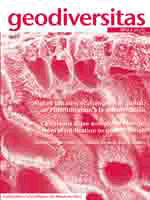Thick rhodolith beds occur in the transgressive and highstand systems tracts of the early Pliocene sequence in the Carboneras Basin in SE Spain. Rhodolith beds accumulated in mid-to-outer ramp settings and in the leeside of a spit platform during the transgressive interval, whereas rhodolith concentrations in the highstand deposits only formed in the mid-to-outer ramp at the southern margin of the basin. The elevation of rhodolith beds compared with coeval shore deposits suggests that the beds developed at water depths of several tens of metres (probably less than 50m). This palaeodepth estimate is consistent with the composition of algal assemblages, which are dominated by melobesioids common in relatively deep platform environments in the modern Mediterranean Sea. Lithothamnion minervae Basso, 1995, L. philippii Foslie, 1909, and Mesophyllum alternans (Foslie) Mendoza & Cabioch, 1998 with subordinate Phymatolithon calcareum (Pallas) Adey & McKibbin, 1970 and M. macroblastum (Foslie) Adey, 1970 and lithophylloids of the Lithophyllum incrustans Philippi, 1837-L. racemus (Lamarck) Foslie, 1901 complex are the most common of a total of 21 recorded species. All the identified algal species are also living in the present-day Mediterranean except for the extinct Lithothamnion ramosissimum (Reuss) Piller, 1994 and for the recent Spongites decipiens (Foslie) Chamberlain, 1993, which has been reported in the Indo-Pacific and South Adantic, but not in the Mediterranean. Moderate energy and low sedimentation rates promoted development of rhodolith beds in the transgressive deposits, but they are not exclusive to the transgressive systems tract as they continued to accumulate at the southern margin during the highstand, beyond the influx of siliciclastics that reduced carbonate production in the rest of the basin. Isolated pillars (up to 90 cm high) or irregular patches (up to 2 m high and 7 m wide) of coralline algal-bryozoan-bivalve bioconstructions occur in outerramp fine-grained calcarenites. Despite their similarities to pillars and low relief buildups constructed by coralline algae (“coralligène de plateau”) in the present-day Mediterranean Sea, these bioconstructions are unique as bryozoans are the main builders and coralline algae (L. philippii and M. lichenoides) play only a secondary role. In contrast with modern Mediterranean coralline algal buildups, the lack of bioclastic debris derived from the build-ups in the surrounding fine-grained sediments and their general morphology suggest that the Pliocene bioconstructions in the Carboneras Basin did not create significant positive relief on the seafloor.
How to translate text using browser tools
1 March 2012
Palaeoenvironmental and stratigraphic significance of Pliocene rhodolith beds and coralline algal bioconstructions from the Carboneras Basin (SE Spain)
Julio Aguirre,
Juan C. Braga,
Jose M. Martín,
Christian Betzler
ACCESS THE FULL ARTICLE
It is not available for individual sale.
This article is only available to subscribers.
It is not available for individual sale.
It is not available for individual sale.

Geodiversitas
Vol. 34 • No. 1
March 2012
Vol. 34 • No. 1
March 2012
bassin de Carboneras
Carboneras Basin
constructions à algues corallines
coralligène
coralline bioconstructions
Couches à rhodolithes
Espagne




